With the rise of globalization, businesses and individuals are seeking the best machine translation software to navigate the world of multilingual communication seamlessly.
Machine Translation (MT) stands at the forefront of this linguistic revolution, offering an automated solution for translating text or speech from one language to another.
From multinational corporations to individual travelers, MT tools have revolutionized communication and accessibility, dismantling language barriers and fostering global connections.
The journey of MT technology is a story of relentless advancement. Early rule-based systems, which relied heavily on linguistic rules and dictionaries, have evolved into today’s sophisticated neural network-based models.
These modern systems use artificial intelligence to learn from vast amounts of data, resulting in more accurate, remarkably fluent, and contextually appropriate translations.
This evolution marks a significant leap in the technology’s ability to understand and translate nuances of language, adapting to various linguistic and cultural contexts.
MT’s impact is widespread, touching diverse sectors.
Businesses leverage it to tap into international markets, opening doors to global audiences. Educational institutions use MT to democratize access to knowledge, translating academic materials into multiple languages.
In healthcare, MT aids in translating patient information, facilitating better care in multicultural settings.
Even the entertainment industry isn’t left behind, with media companies using MT to bring diverse content to a global audience.
However, despite its advancements, MT is not without challenges.
Complex or specialized language can trip up even the most advanced algorithms, and subtle nuances or cultural references may get lost in translation. High-quality source material is crucial, and human oversight remains necessary to ensure accuracy and contextual relevance.
When evaluating MT software, factors like accuracy, fluency, adaptability, domain-specific expertise, ease of use, and cost-effectiveness come into play. Each application has its strengths and is suited to different contexts and needs.
This article will explore the top contenders reshaping how we communicate across languages.
Stay tuned to discover how these tools can aid your personal or business communication needs and which software stands out in this rapidly evolving field.
What is machine translation?
Machine translation (MT) is a rapidly evolving field of artificial intelligence (AI) that enables automatic translation of text or speech from one language to another. It has revolutionized communication across cultures and borders, breaking language barriers and fostering global connections.
Bridging languages through automatic text or speech conversion and intertwined with advancements in artificial intelligence and natural language processing, this field has seen a surge in efficacy and popularity.
At its core, MT operates in two primary forms. Rule-based MT (RBMT) uses linguistic rules for translation, whereas statistical MT (SMT) leverages statistical models from extensive bilingual text data.
However, the landscape of MT has been revolutionized by the advent of neural machine translation (NMT). NMT, employing deep learning algorithms, harnesses vast data sets to produce more accurate and notably more fluent translations.
The applications of MT span various domains.
In business, it breaks language barriers in marketing and customer support. Educational institutions use it to access multilingual resources and foster communication in diverse academic settings.
Travelers benefit from translated guides and signage, enhancing their experiences.
Media entities expand their reach by translating content for a global audience, while governments use MT for effective communication through translated official documents and announcements.
Despite these strides, MT isn’t without its challenges.
Accuracy can falter with complex or nuanced language, often missing cultural references or subtle meanings. The fluency of MT translations might not match the natural flow of human language.
Moreover, MT systems sometimes struggle with highly specialized or technical language.
Given these limitations, the role of human oversight remains indispensable.
Human review ensures that translations achieve the highest accuracy, maintain linguistic flow, and respect cultural nuances.
In sum, while MT marks a significant leap in language technology, it functions best as a tool complemented by human expertise.
What is the best machine translation software?
Finding the best machine translation software for your business needs can often feel like navigating a complex maze.
With many options available, identifying the one that aligns with your specific requirements demands careful consideration.
The best MT tool balances speed and accuracy, offering features that cater to diverse business scenarios. From translating customer support tickets to localizing marketing content, the right tool significantly affects how your business communicates globally.
Several key factors come into play when selecting an MT tool. The quality of translation is paramount — it should be accurate and natural-sounding. Integration capabilities also matter as seamless integration with existing business systems enhances efficiency.
Additionally, the software’s ability to handle different languages and dialects, including less commonly spoken ones, is crucial for businesses aiming for a global reach.
On the other hand, privacy and security features are non-negotiable, especially when dealing with sensitive or proprietary information.
Moreover, user-friendliness and technical support can significantly impact your team’s ability to leverage the tool effectively.
This article will guide you through this landscape, offering insights into the top MT software for every business need in 2024.
Is ChatGPT a machine translation?
This is a common question in the translation industry. While both use artificial intelligence, they serve different purposes.
ChatGPT, a type of language model, excels in generating human-like text. It’s designed for conversations, answering questions, and creating content.
On the other hand, machine translation focuses solely on converting text from one language to another. Tools like Google Translate are prime examples. They decode the source language and reproduce its meaning in another language.
ChatGPT, however, goes beyond mere translation. It understands context, generates creative responses, and adapts to various topics.
This distinction is crucial.
The best machine translation software tools are great for quick, literal translations. But for nuanced, context-aware conversations, ChatGPT stands out. It’s not a traditional translation tool, but its AI-driven capabilities bring a unique value to language services.
What is the best AI for translation?
In 2024, identifying the best AI for translation hinges on understanding the nuances between AI and machine translation.
AI, or artificial intelligence, serves as the broader umbrella under which machine translation operates. It encompasses a range of technologies, from natural language processing to learning algorithms.
Machine translation, a specialized AI application, focuses solely on converting text or speech from one language to another.
The leading AI in translation this year excels by integrating advanced algorithms that understand context, cultural nuances, and idiomatic expressions.
Unlike earlier versions, it goes beyond mere word-for-word translation. This AI interprets the meaning behind sentences, ensuring translations are not only accurate but also culturally relevant.
Its superiority lies in continuous learning capabilities. With each translation, the AI refines its understanding of linguistic subtleties. This results in output that is increasingly sophisticated and tailored to the target audience.
For businesses and individuals requiring precise and context-aware translations, this AI represents a significant leap forward.
Moreover, its user-friendly interface and swift processing make it accessible to a broad range of users, from language professionals to casual users.
In essence, the best AI for translation in 2024 isn’t just a tool; it’s a dynamic solution that adapts and evolves with the complexities of human language.
What is the best machine translation software?
The best machine translation software streamlines the process of adapting your content for international audiences. This includes transforming everything from business documents to your website and promotional materials into various languages.
In the past, translation tools faced challenges in accurately capturing language nuances. However, advancements in machine learning and AI-driven technologies have markedly improved their precision. These tools offer an enhanced understanding of linguistic subtleties, improving translation quality.
While some speech-to-text and text-to-speech services and transcription providers offer translation features, we focus on comprehensive solutions tailored to global business needs. Although we still recommend human review for complex or technical documents, high-quality translation software can now deliver reliable results with minimal editing required.
In the following sections, we’ll introduce some of the finest translation software available to meet your diverse, multilingual requirements.
SDL Trados Studio – Best for professional translation teams
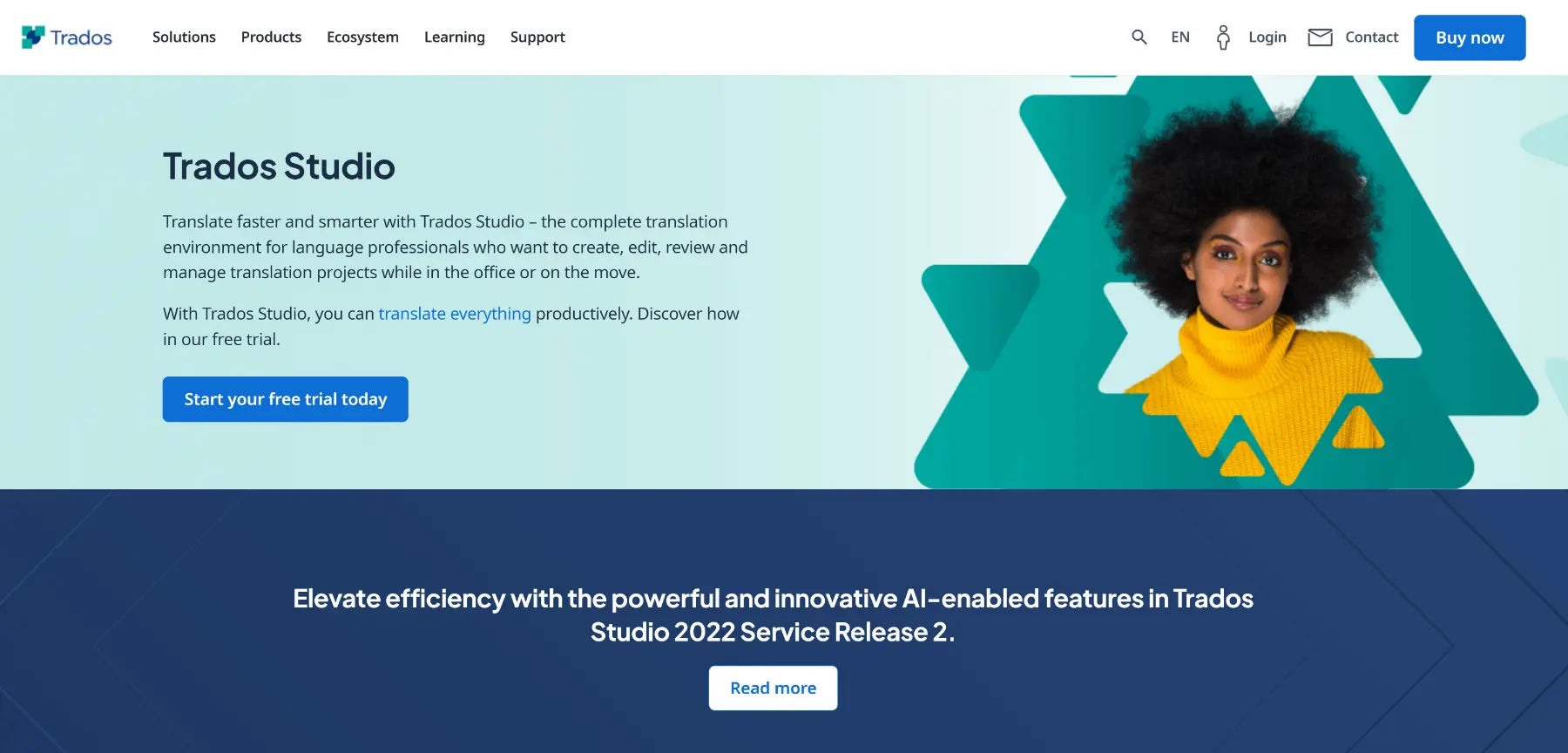
SDL Trados Studio stands out as a comprehensive solution in machine translation software for 2024, catering to language professionals seeking to create, edit, review, and manage translation projects.
It’s a versatile tool, ideal for use in the office or on the go, and it has established itself as a favorite among computer-assisted translation (CAT) tools.
Trados Studio integrates three core translation technologies: translation memory (TM), terminology management, and machine translation (MT), which collectively enhance the efficiency and consistency of translations.
Its AI-powered features, like Smart Help and Smart Review, employ advanced algorithms to improve productivity and translation quality.
The integration of Language Weaver for MT and various Large Language Models (LLMs), such as ChatGPT and Google-PaLM, further bolster its capabilities, making it a potent tool for tackling diverse translation challenges.
However, Trados Studio is not without its limitations.
While it boasts robust features, the complexity of these tools might pose a learning curve for new users.
Additionally, the software primarily caters to professional translators and businesses, potentially limiting its accessibility to casual or infrequent users.
Trados Studio is ideal for translation professionals and global businesses, particularly for large-scale projects and specialized translation tasks.
It offers extensive language support and advanced project management features, making it suitable for enterprises looking to streamline their translation processes.
Additionally, the Studio Subtitling app extends its functionality to audiovisual translation, addressing the specific needs of subtitle translators with features like real-time video preview and time code editing.
In essence, SDL Trados Studio represents a fusion of sophisticated translation technology and user-centric design, making it a top contender in the machine translation software arena for 2024.
Although complex, its blend of innovative features offers significant advantages for professional translators and businesses aiming for high-quality, efficient translation solutions.
Smartcat – Best for collaborative translation projects

In the ever-evolving landscape of machine translation, Smartcat is a beacon of innovation, particularly for businesses prioritizing efficiency and accuracy.
This innovative platform offers an easy-to-use interface that simplifies translating various content types, making it accessible to anyone within an organization. Its unique selling point lies in integrating OpenAI’s GPT-4, which elevates the quality of translated content through highly accurate and context-aware AI translation workflows.
Smartcat’s adaptive AI learns from your content and edits and allows the reuse of up to 80% of existing translations, reducing time and costs.
This feature especially benefits businesses that frequently update or repurpose content across multiple languages.
Additionally, the platform supports over 280 languages and 50+ file formats, ensuring versatility and broad applicability.
Collaboration is another strength of Smartcat.
It allows unlimited users to collaborate seamlessly on translation projects, offering real-time communication and synchronized assets like glossaries and translation memories.
This collaborative environment is perfect for teams, including in-house staff and freelancers.
However, while Smartcat offers many features and a vast network of over 500,000 professional linguists, some businesses might find its extensive functionalities more than they need, notably smaller enterprises with more straightforward translation requirements.
Smartcat is ideal for businesses looking for a comprehensive, AI-powered translation solution.
From marketing and sales departments needing quick content translations to product teams developing multilingual applications, Smartcat’s blend of advanced technology and user-friendly design makes it a top choice.
Its ability to handle various content types, from technical documents to creative marketing materials, makes it a versatile tool for various industries.
In conclusion, Smartcat stands out as a powerful and flexible translation tool, blending the latest AI technology with user-friendly features for effective, high-quality translations.
memoQ translator pro – Best for freelance translators
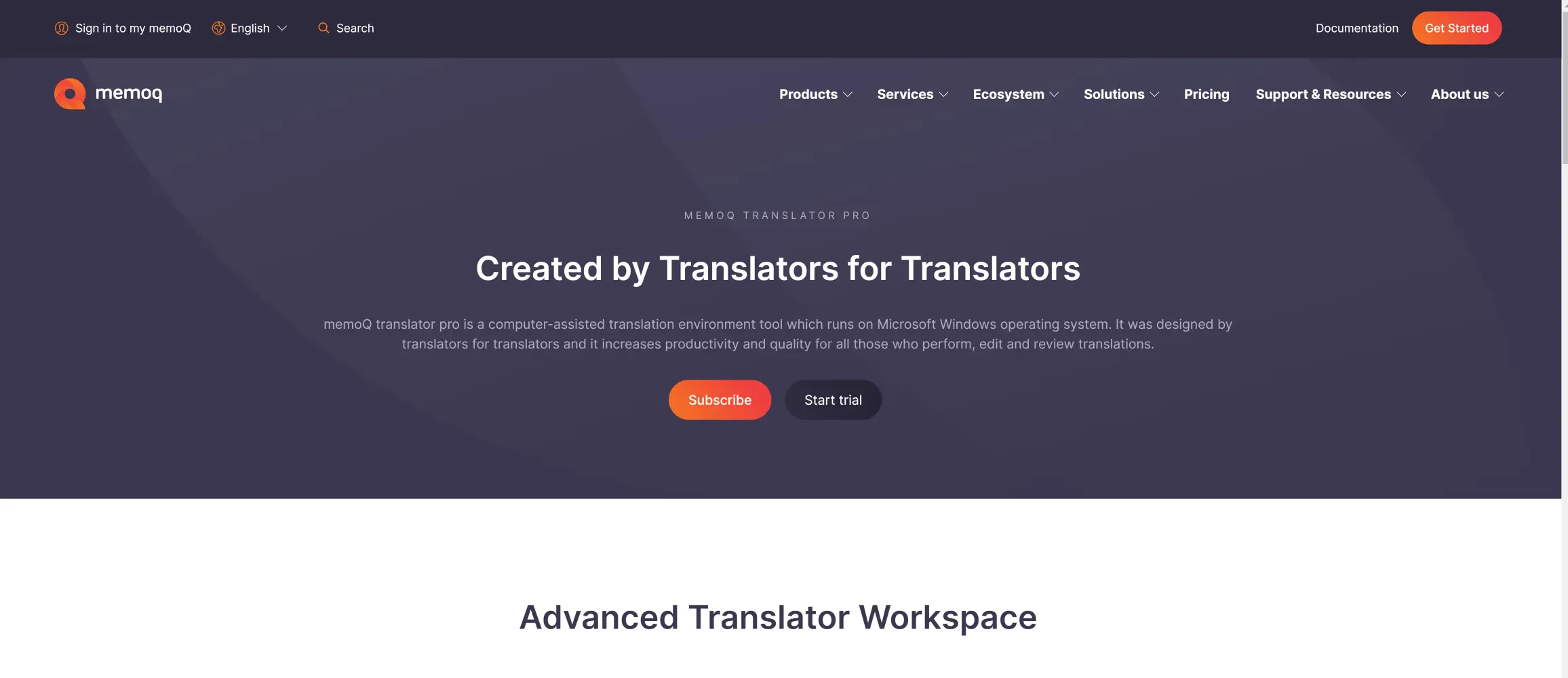
In 2024, machine translation software memoQ translator pro distinguishes itself as a top contender.
Tailored for translators, this computer-assisted translation tool enhances productivity and quality in translation tasks.
It runs on the Microsoft Windows operating system and is designed to streamline the translation process for various types of content.
This tool’s features are robust and diverse, catering to various translation needs. It allows users to reuse previous translations and create comprehensive glossaries.
The termbase feature lets you add words and expressions easily, while its translation memory ensures you never have to translate the same segment twice.
For those looking for efficiency, the LiveDocs feature is a boon, allowing the reuse of existing documents as reference materials.
Moreover, its compatibility with other tools and support for over 100 languages make it a versatile choice for translators.
MemoQ Translator Pro benefits enterprises, language service providers, and professional translators. It supports a variety of industries, including life sciences and game localization, ensuring accurate and timely translations.
The software is also highly user-friendly, making it accessible even for those not tech-savvy while still providing advanced controls for power users.
Despite its many advantages, the tool may present a steep learning curve for new users, and its Windows-only compatibility could be a limitation for users of other operating systems.
Starting at €360 or $400 per year for an annual subscription, the cost may also be a consideration for freelance translators or smaller enterprises.
MemoQ Translator Pro is a comprehensive solution for enhancing translation productivity and quality. Its features and support services make it a valuable asset for translators and businesses seeking clarity and consistency across different languages in global markets.
Smartling – Best for enterprise localization
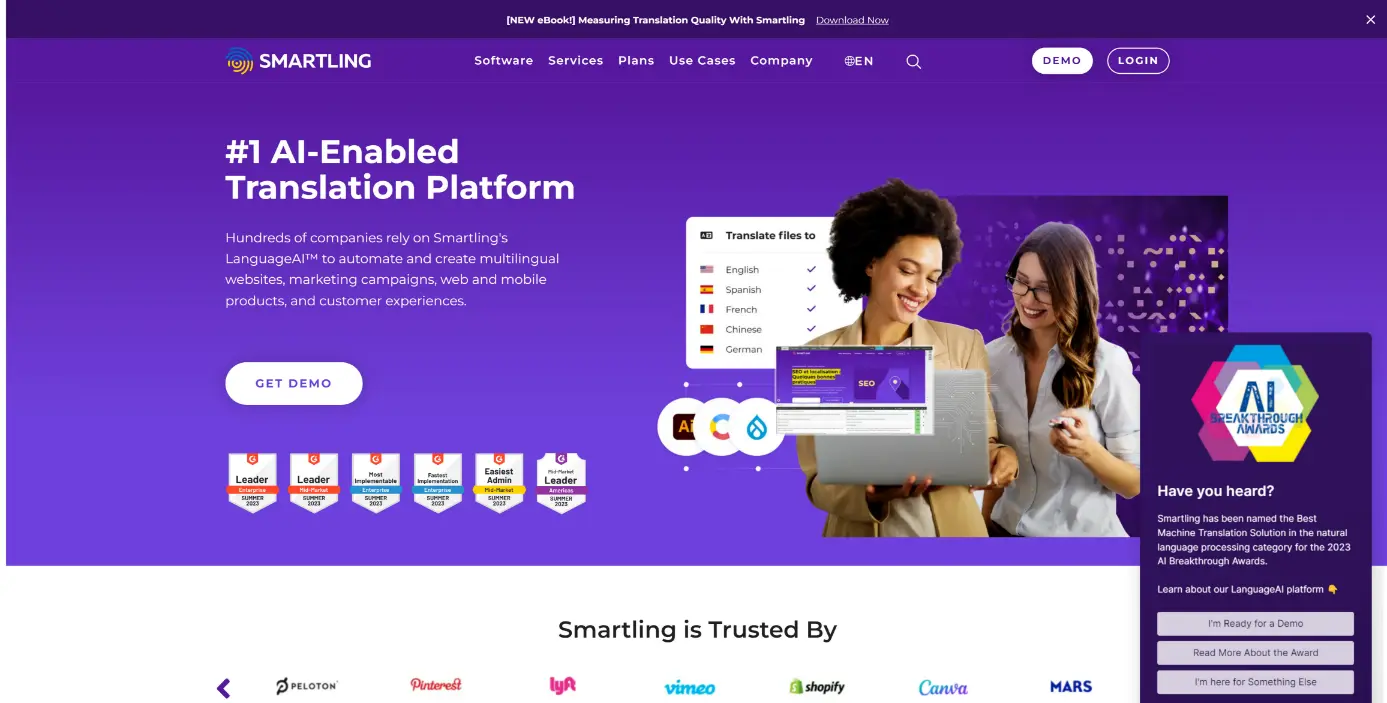
Smartling shines brightly in the competitive world of 2024’s machine translation solutions.
It’s an AI-driven platform that comprehensively manages translation projects, catering to various content types such as web pages, marketing materials, and customer support content.
Smartling’s hallmark is its 100% translation quality guarantee, promising faster market delivery and significant cost savings.
One of Smartling’s most prominent features is its Neural Machine Translation (NMT) Hub.
This state-of-the-art engine uses a multi-engine approach for selecting the best machine translation engine for specific content and locale pairs, vastly improving translation quality.
It can deliver translations up to 350% higher in quality compared to single-engine approaches.
Smartling’s AI models are trained on vast volumes of data, ensuring top-notch quality across multiple translation directions and content types.
Smartling’s Translation Proxy and computer-assisted translation (CAT) tool are other notable features. The Proxy automatically updates the website copy for translation, instantly delivering localized, SEO-friendly versions.
The CAT tool previews how translated content will appear, enhancing accuracy and consistency.
Additionally, Smartling offers robust performance analytics, including workflow efficiency and cost estimates, helping businesses track and optimize their translation processes.
However, Smartling’s comprehensive nature means a learning curve for new users, though its customer success team aids in quick acclimation.
The platform centralizes customized linguistic assets like glossaries and style guides, and its dynamic workflows automate most translation projects.
It also integrates with numerous tools like content management and ecommerce platforms, ensuring streamlined workflows.
Smartling is ideal for businesses seeking an end-to-end translation solution that combines advanced AI capabilities with efficient project management.
Its focus on quality, speed, and integration makes it suitable for enterprises needing to scale their translation efforts across various languages and content types.
With Smartling, businesses can expect a seamless translation experience, ensuring brand consistency and rapid market access.
Phrase – Best for agile software localization

The 2024 machine translation scene sees Phrase taking a leading role as a versatile and efficient choice.
Designed to cater to a broad spectrum of business needs, Phrase integrates seamlessly with numerous platforms like Zendesk Suite, Adobe Marketo Engage, and WordPress, among others. It supports over 400 languages, making it an exceptionally versatile tool for global business operations.
Phrase excels in user-friendliness and functionality, boasting a 4.6 out of 5 rating from users. Its ease of use and customer support are highly praised, scoring 4.5, indicating a solid balance of functionality and user accessibility.
The tool is particularly beneficial for businesses of all sizes, from small startups to large enterprises, due to its expansive language support and integration capabilities.
However, like any tool, Phrase has its limitations.
Some users have noted occasional slowdowns with large documents, and the lack of a free version might be a drawback for smaller businesses or individual users.
Starting at $29 per month, the price can be a consideration for those on a tight budget, although a free trial is available to test its capabilities.
Phrase is an excellent choice for businesses seeking to enhance their global reach through translation. Its strength lies in its ability to integrate with various other services and platforms, offering a comprehensive solution for translation needs.
While it might not be the perfect fit for every user, particularly those with tight budgets or needing offline capabilities, its overall performance and ease of use make it a strong contender in the machine translation software market.
Lokalise – Best for fast-paced tech companies
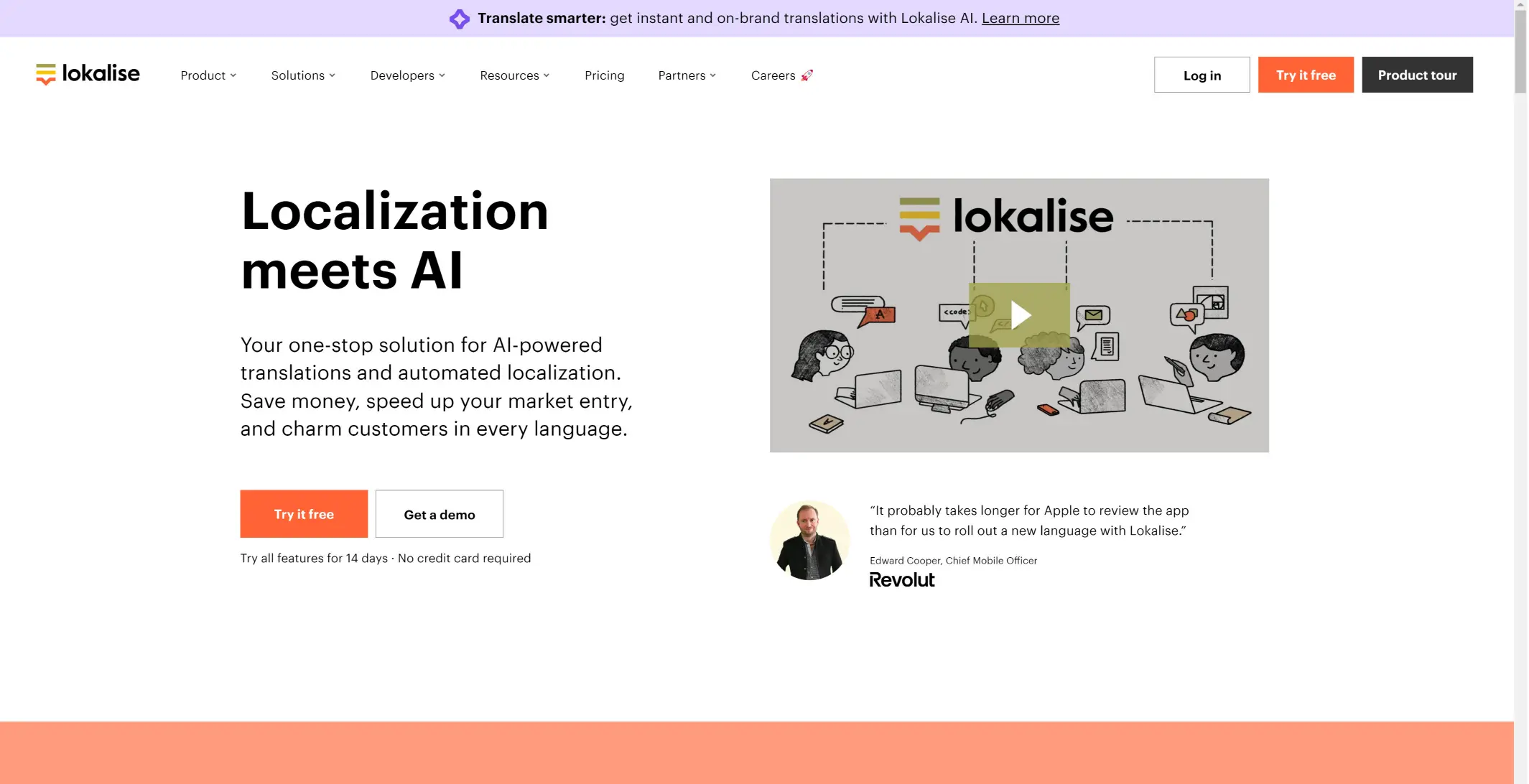
In 2024, Lokalise will rise to prominence in the 2024 machine translation software arena, especially for those needing comprehensive localization services.
Lokalise is more than just a translation tool; it’s a dynamic platform that integrates translation and localization management, designed to enhance workflow and accelerate market reach. Its appeal lies in its ability to serve diverse industries and business sizes, making it a versatile option for various localization needs.
Lokalise’s standout feature is its integration of generative AI translation, which promises to automate and streamline one of the most time-consuming aspects of localization: the translation process.
This feature ensures that translations are not only fast but also remarkably accurate, taking into account factors like style, tone of voice, and industry specifics.
Moreover, Lokalise AI evaluates the quality of translations, providing QA reports to pinpoint areas needing attention, making it easier for language professionals to focus on critical errors.
The platform supports many content types, from websites and documents to marketing materials and emails, and is adaptable across different industries.
It also boasts over 50 integrations, allowing seamless workflow management.
Lokalise AI stands out for its capacity to translate large quantities of content quickly and efficiently, maintaining consistency across different pieces of content. The tool’s ability to handle translations of highly specialized or technical content adds to its robustness.
However, Lokalise may have its limitations. While it offers high accuracy, there might still be a need for minor adjustments in translations, depending on language pairs and content complexity.
Also, the sheer breadth of features and capabilities might be overwhelming for smaller projects or businesses with more straightforward localization needs.
Lokalise is ideal for businesses seeking a comprehensive solution for their localization and translation requirements, particularly those dealing with large-scale projects or various content types.
Its ability to deliver fast, accurate, and context-aware translations makes it a powerful tool for any business looking to expand its global reach without compromising on the quality of localized content.
Transifex – Best machine translation software for community-powered translations
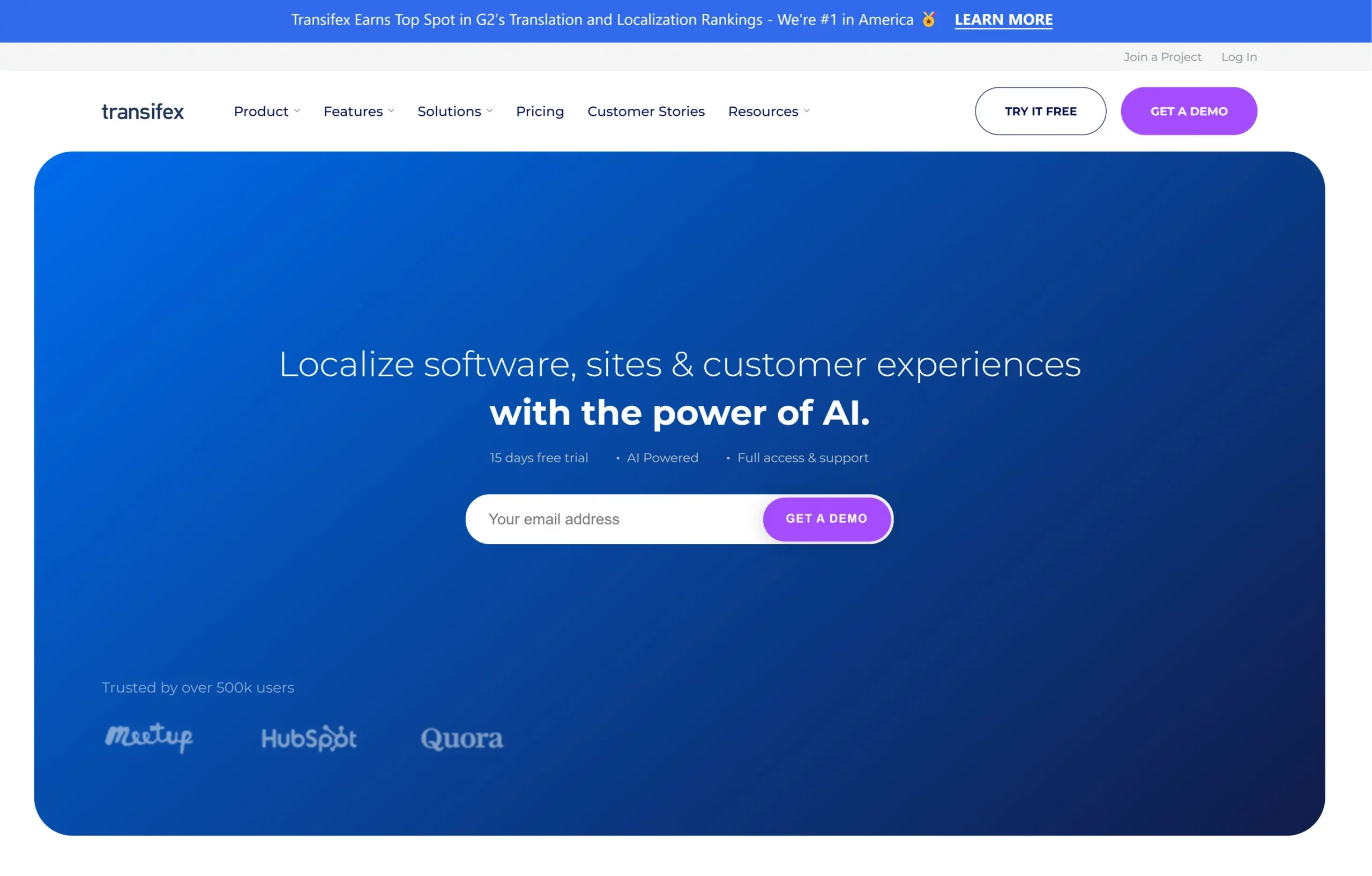
Transifex, a cutting-edge translation management software, sets itself apart for those seeking efficient localization solutions in the machine translation software market.
It offers a comprehensive platform for translating and managing digital content, making it particularly valuable for translating software, websites, mobile apps, and even subtitles.
Transifex’s cloud-based system allows seamless integration into various workflows, making the localization process straightforward and customizable.
Critical features of Transifex include powerful translation tools, centralized file and content hosting, and robust team management capabilities. These enable parallel work on the same content, increasing efficiency and collaboration among team members.
The platform’s robust and flexible API integrates seamlessly into the development lifecycle, ensuring that localization is a continuous, automated process.
Transifex also boasts an impressive array of translation workflows, allowing users to customize their localization process for faster and more efficient outcomes. Monitoring and reporting tools provide insights into translation progress, helping teams stay on top of their projects.
One of the standout aspects of Transifex is its focus on improving translation quality and speed. The platform provides translators with all the necessary tools, including a CAT editor, translation memory, and quality assurance tools, to enhance translation accuracy and reduce turnaround times.
Additionally, Transifex AI, the platform’s AI-driven component, offers human-quality translations at massive scale and record speeds, leveraging the latest natural language processing technology.
Despite its many advantages, some users might find the abundance of features overwhelming, especially if their localization needs are straightforward.
However, for businesses seeking a comprehensive, customizable solution for their diverse localization needs, Transifex is an excellent choice.
The platform is particularly well-suited for managers, engineers, and translators in enterprise settings, where the demand for efficient, high-quality localization is paramount.
With its user-friendly interface and robust feature set, Transifex stands out as a top-tier solution for 2024’s global translation and localization needs.
Redokun – Best machine translation software for InDesign document translations
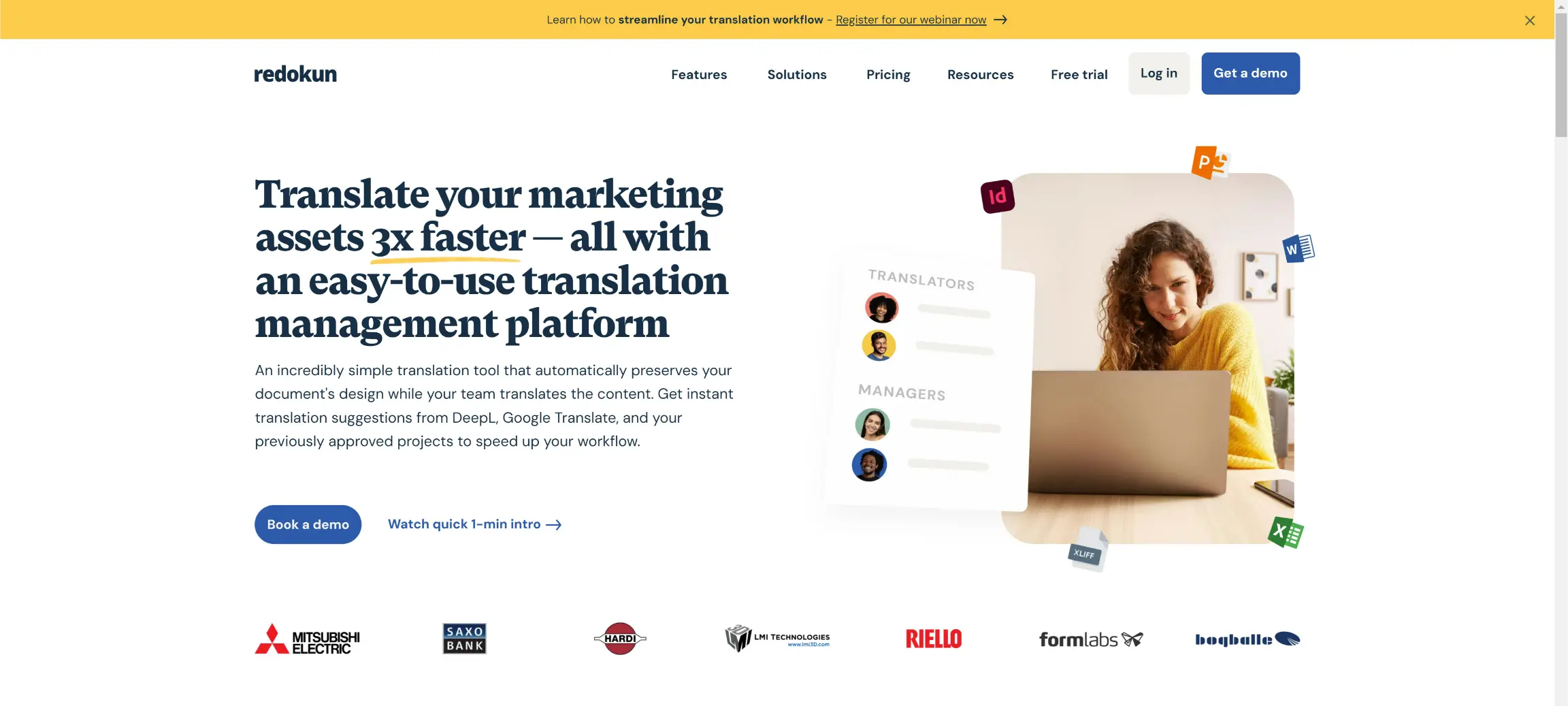
Redokun claims a unique spot in the 2024 landscape of machine translation tools, offering a seamless and efficient translation experience. It’s designed to simplify the translation process, making it less time-consuming and more productive for teams.
This tool shines in its ability to translate documents quickly.
Users have praised Redokun for its impressive speed, reporting significant reductions in production time and costs.
For instance, businesses have experienced a 70% savings in production time and an 80% reduction in translation costs. This efficiency is coupled with a promise of delivering documents to market three times faster than traditional methods.
Redokun is incredibly user-friendly, making it accessible even for those new to translation software. Its simple, intuitive interface allows teams to translate online almost immediately after document uploading.
This ease of use doesn’t come at the cost of functionality.
Redokun offers powerful translation tools like Translation Memories, Machine Translation, Glossary, and the ability to make quick revisions. These features help maintain consistency across translations and streamline the workflow.
Another significant advantage is its ability to support various document formats while preserving the original layout and style. This feature is particularly beneficial for businesses needing to translate various content types without worrying about formatting issues.
However, while Redokun excels in many areas, it may not be the perfect fit for all. Its simplicity, while a boon for many, might not satisfy those looking for highly specialized translation features.
Also, starting from $70 per month, the pricing might be a consideration for smaller businesses or individual users.
Redokun is ideal for businesses of all sizes, especially those looking to enhance global communication without investing heavily in complex software.
It benefits marketing managers, designers, translators, and product managers who need quick, reliable, consistent translations across different languages and document types.
The software’s ability to integrate machine translation with human editing makes it a practical choice for businesses striving for high-quality, culturally sensitive translations.
Geoworkz – Best machine translation software for translation agencies

Geoworkz, a Lionbridge business unit, offers the Translation Workspace a solution that stands out in the machine translation software market.
As a Software-as-a-Service (SaaS) solution, it provides an on-demand, subscription-based approach to translation technology, catering to many users, from freelancers to large enterprises. It supports numerous languages and scripts, making it a versatile tool for global communication.
This platform is designed to enhance productivity and business results, offering plans that start at competitive prices and include essential support, zero maintenance, and flexible word limits.
Users can manage their accounts, track usage, and access various resources, including training materials and documentation.
Additionally, Translation Workspace is compatible with standard file formats like XLIFF and TMX and operates efficiently on Windows systems with different Internet Explorer and Firefox versions.
However, user reviews suggest some drawbacks.
Users have criticized its interface as clunky and not user-friendly. The terminology feature and file browsing are also points of concern, with users finding them inefficient and cumbersome.
Moreover, the subscription model, while flexible, might become costly for high-volume users. Users have also reported issues with customer support, indicating potential communication and resolution challenges.
Geoworkz’s Translation Workspace suits those who require a versatile, language-rich translation tool and are comfortable with a SaaS model.
It’s beneficial for businesses looking to expand globally and needing to translate various types of content.
However, its interface and support issues may not be the best fit for everyone, particularly those requiring extensive customer support or having specific interface preferences.
Thus, while Geoworkz offers a comprehensive solution for translation needs, potential users should carefully weigh its pros and cons against their specific requirements.
Crowdin – Best machine translation software for developers and content creators
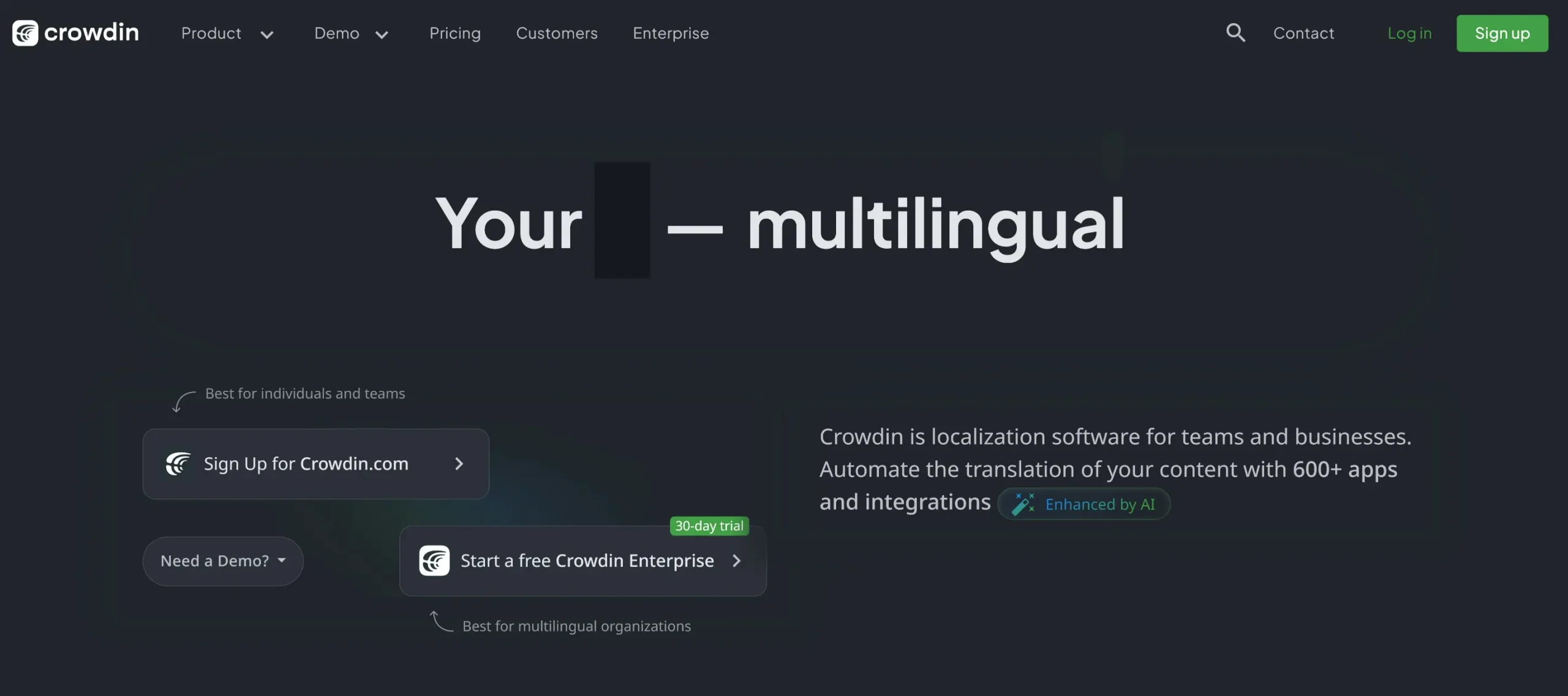
Crowdin will be a prominent player in the machine translation software landscape in 2024 and offers an innovative solution for localization projects.
It integrates AI technologies to provide faster, context-aware translations, significantly improving speed and accuracy.
Crowdin is well-suited for managing translations across various platforms, from web and mobile apps to documents, with a particular emphasis on project consistency.
The platform boasts a powerful AI assistant that leverages large language models (LLMs) for more nuanced translations. It offers continuous fine-tuning, allowing users to update terminology and translation memories, which enhances the accuracy of the AI’s output.
Additionally, Crowdin’s string-based projects feature simplifies the management of source and target languages, which is especially useful for multi-platform products.
Integration with tools like Webflow and Figma and features like excluding non-essential text and automated key creation further streamline the localization process.
However, the wealth of features and options Crowdin offers can sometimes be overwhelming for new users.
Also, while Crowdin provides extensive support and customization options, the pricing can be steep, especially for smaller businesses or individual users.
Despite these minor drawbacks, Crowdin’s strengths in collaboration, integration, and AI-driven translation make it an attractive choice for organizations of various sizes, particularly those engaged in comprehensive, multilingual localization projects.
Overall, Crowdin is best suited for businesses and organizations seeking a robust, AI-enhanced solution for extensive localization projects.
Its ability to handle large volumes of content across multiple languages and platforms and its advanced AI capabilities make it a top choice for those looking to streamline their translation workflows and expand their global reach.
Amazon Translate – Best machine translation software for developers needing integrations
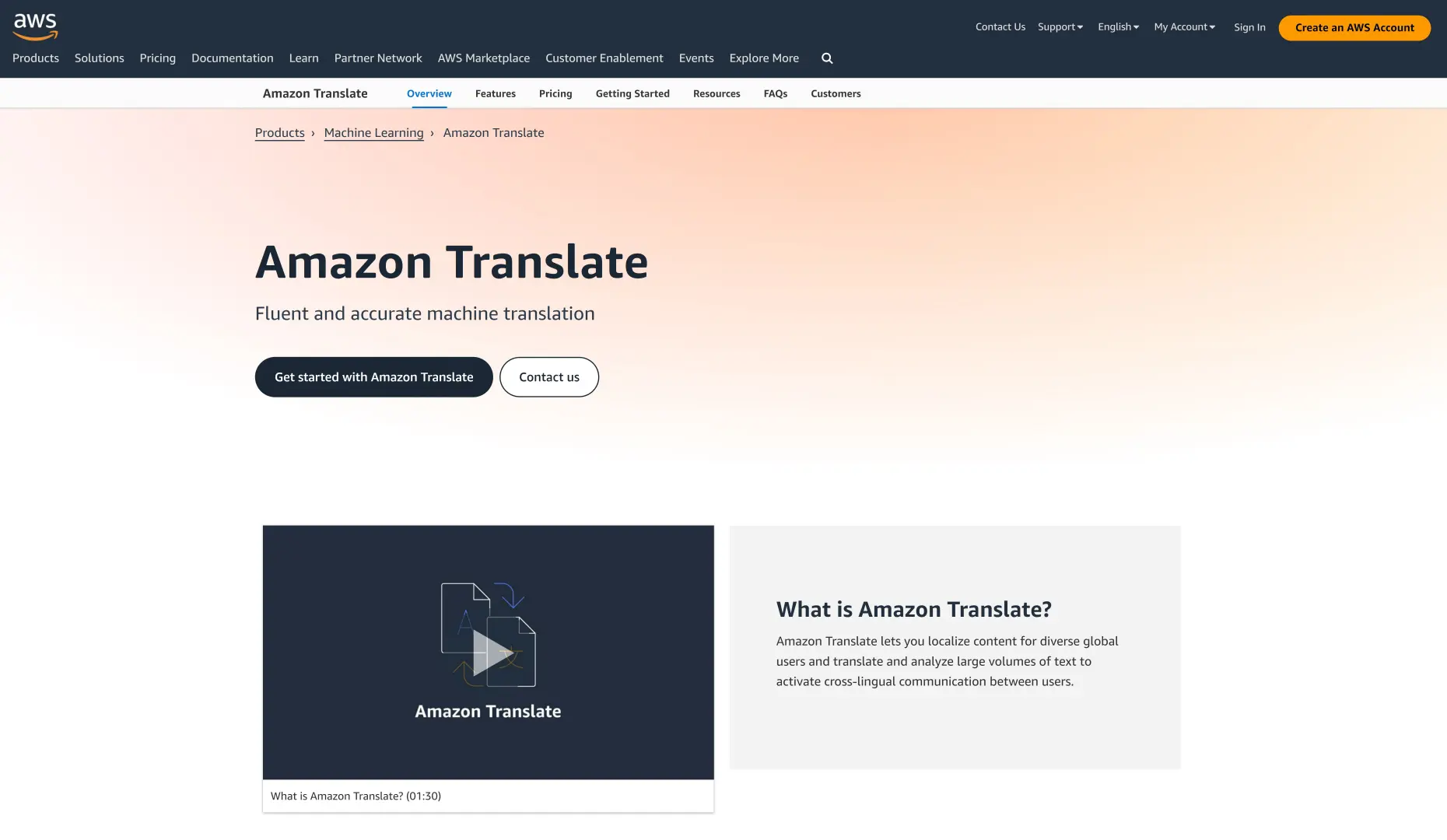
In the dynamic world of machine translation, Amazon Translate emerges as a robust solution for businesses looking to globalize their content in 2024.
This neural machine translation service specializes in delivering fast, high-quality, and customizable language translations, making it a go-to tool for various enterprises.
Amazon Translate excels in localizing content for a diverse global audience, efficiently translating and analyzing large volumes of text to facilitate cross-lingual communication.
Its unique selling point lies in its ability to offer batch and real-time translations through a single API call.
Additionally, it allows customization of machine learning-translated output to include brand names and other unique terms, making it highly versatile.
The service operates on a pay-as-you-go model, with the first 2 million monthly characters free for the first 12 months.
This model makes it accessible for businesses of all sizes.
Amazon Translate supports many languages, from typical Spanish and Chinese to less prevalent ones like Tamil, catering to a broad spectrum of linguistic needs.
However, user reviews indicate some mixed feelings.
While many appreciate its ease of use and functionality, others find it complicated without proper training. A common critique is the necessity of a credit card for occasional use, which can deter infrequent users.
Amazon Translate is ideal for businesses seeking to automate language translation across various channels, including social media, websites, and applications.
Its neural network-based translations ensure fluent and accurate output, crucial for maintaining a brand voice in different languages.
While it is generally reliable, additional human review is advisable to guarantee precision for highly specialized or technical content.
In summary, Amazon Translate offers a comprehensive solution for businesses looking to expand their global footprint, balancing quality, customization, and cost-effectiveness.
Pairaphrase – Best machine translation software for secure business translations
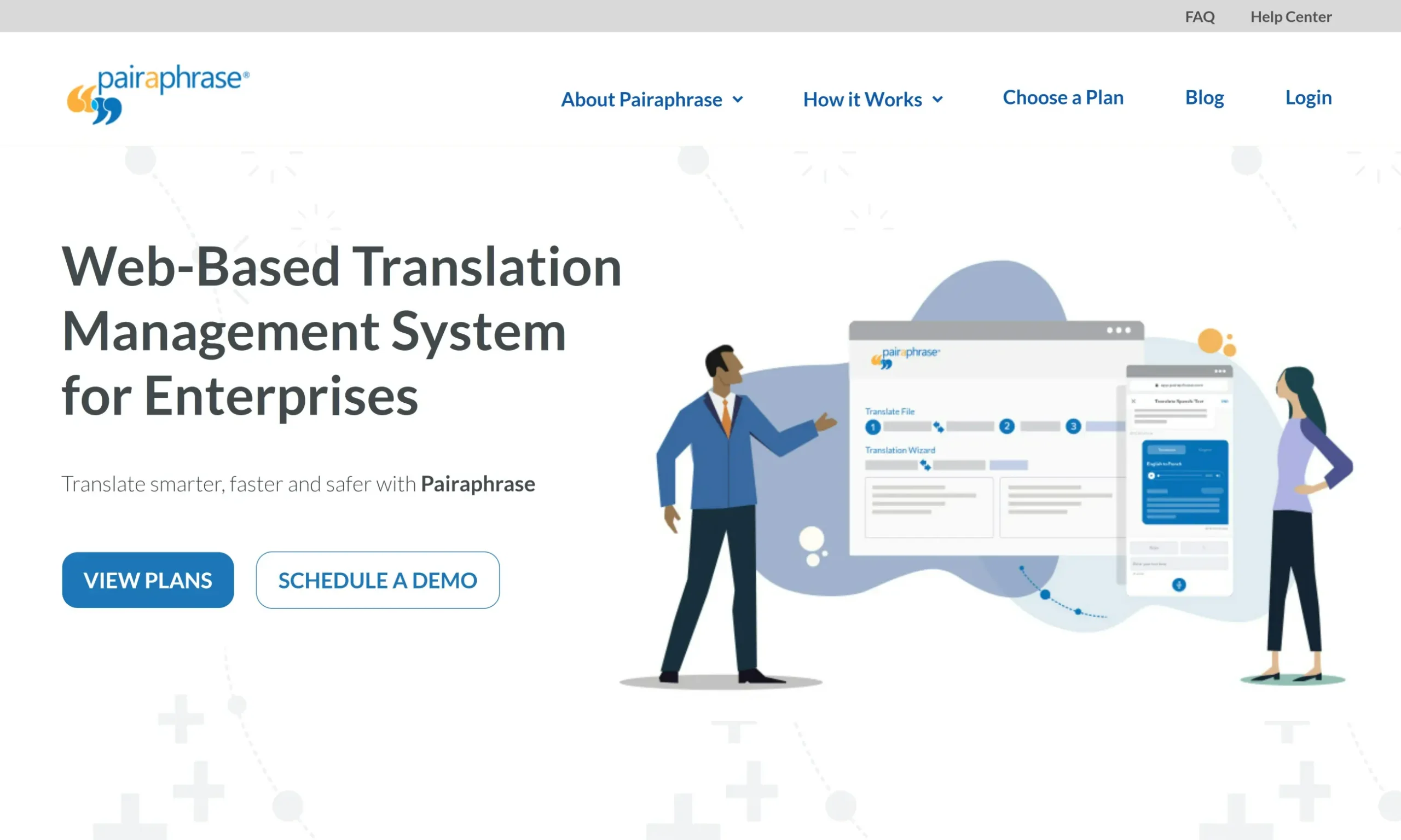
Pairaphrase, a notable player in the machine translation software arena in 2024, offers a comprehensive solution for enterprises looking to navigate the complexities of language translation.
This web-based translation management system (TMS) caters to various business needs, making it a versatile choice for various industries.
Pairaphrase excels in translating and transcribing speech, which is especially useful for businesses needing real-time interpreting. The software also boasts enterprise-level security, ensuring the confidentiality and protection of sensitive data, a critical aspect for organizations dealing with private information.
One of the standout features of Pairaphrase is its optimization for Microsoft Office users.
This integration allows seamless translation of documents from programs like Excel, Outlook, PowerPoint, and Word, ensuring that the translated files maintain a high degree of fidelity to the original.
The platform supports translating 24 file formats, including Word, HTML, PDF, and InDesign, all on a cloud-based platform. This capability ensures that businesses can quickly get a first draft of their translation, with the option to post-edit for enhanced quality.
Pairaphrase also allows batch translation of files, further streamlining the translation process.
Pairaphrase’s utilization of translation memory, machine translation, and artificial intelligence significantly reduces translation costs while increasing efficiency.
The platform’s ability to integrate with existing systems to optimize workflows is a notable benefit, allowing translations to be produced in seconds and minutes.
However, as with any tool, there are considerations to bear. The platform’s extensive features and enterprise-level capabilities might be more than smaller businesses require.
Additionally, the focus on Microsoft Office integration, while a strength for some, might not align with the needs of businesses using different office suites or platforms.
In summary, Paraphrase is a robust choice for enterprises and organizations that require a secure, efficient, and comprehensive translation solution.
Its advanced features and strong emphasis on security make it particularly suitable for businesses handling sensitive information and those deeply integrated with Microsoft Office products.
Weglot – Best for website localization
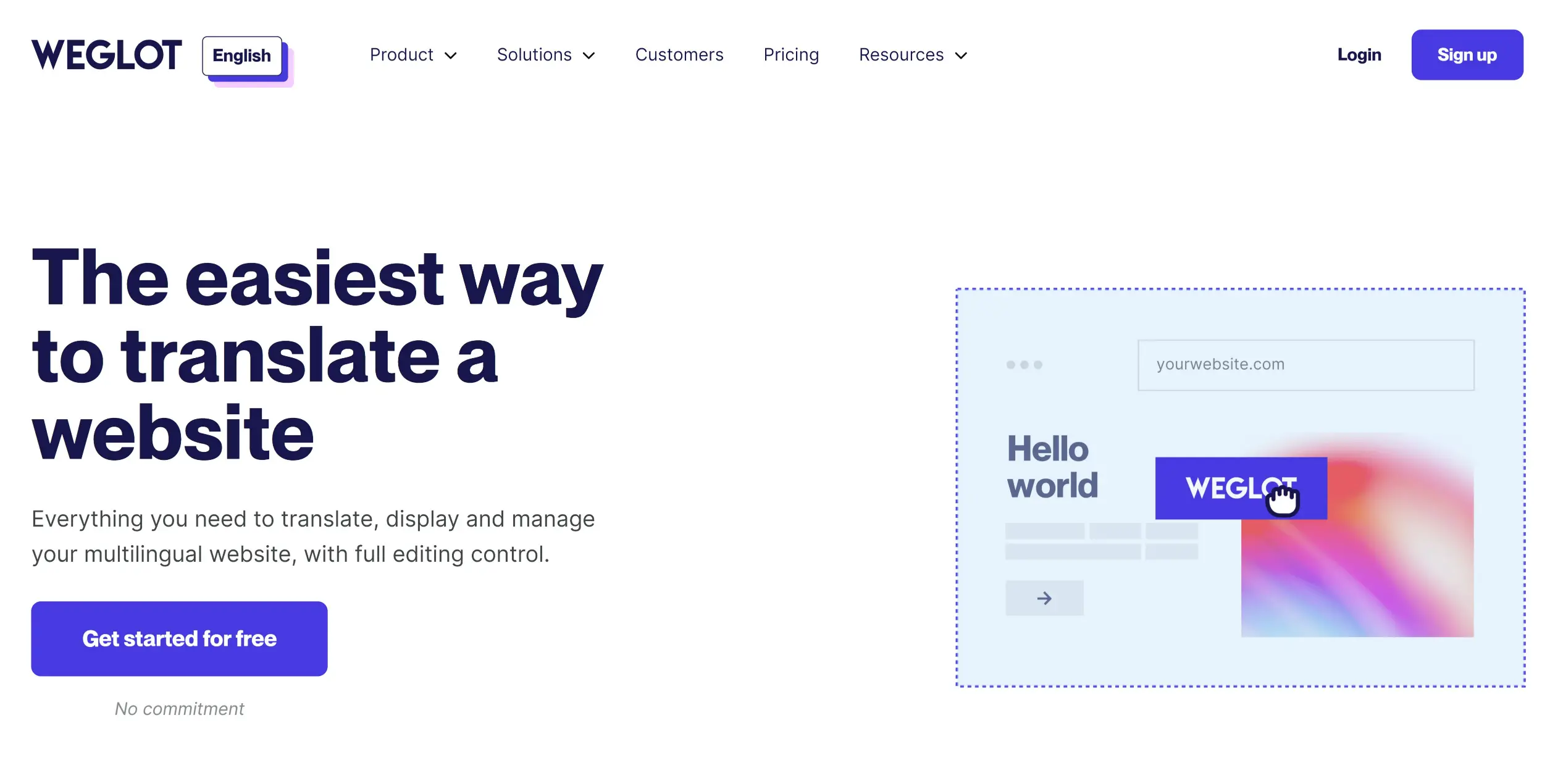
The year 2024 highlights Weglot as a robust and efficient solution for website translation.
This tool simplifies the translation process, making it easy for businesses to reach global markets.
With Weglot, you can effortlessly translate your website into multiple languages, including textual content, images, and SEO metadata.
Weglot’s approach is user-friendly and requires no coding skills, making it accessible for teams without technical expertise.
The integration process is straightforward, and once set up, Weglot automatically detects and translates new content, keeping your website up-to-date in all languages.
One of Weglot’s standout features is its automatic content detection, which replaces the tedious task of manually gathering content for translation. This feature is a game-changer for businesses looking to save time and resources.
Editing and managing translations is a breeze with Weglot. The platform allows easy collaboration, enabling you to add translators or bilingual team members for proofreading and quality control. You can even order professional translation services directly through Weglot, centralizing all your translation needs in one place.
However, while Weglot offers an impressive machine translation layer from providers like Microsoft, DeepL, and Google, it’s important to remember that machine translation is not infallible, especially for complex or nuanced content.
Therefore, Weglot gives users complete control over their translations, allowing human editing to ensure accuracy and cultural appropriateness.
In terms of search engine optimization (SEO), Weglot excels.
The software automatically creates language subdomains or subdirectories and translates metadata, which is crucial for multilingual SEO. This feature helps rank your translated pages in search engines, thus increasing your global online presence.
Weglot’s pricing starts at €15/month, offering a competitive edge for businesses seeking a global digital footprint.
Additionally, a 10-day free trial allows you to test the software’s capabilities on your website without any commitment.
In summary, Weglot is an ideal choice for businesses of all sizes looking to make their websites multilingual.
Its blend of automatic translation, easy editing controls, and SEO features make it a valuable asset for any company aiming to expand its international reach.
XTM Cloud – Best for cloud-based translation management

XTM Cloud is an innovative translation management system (TMS) designed to centralize and streamline localization processes.
It’s a comprehensive solution tailored for businesses seeking to expand their global presence swiftly and effectively.
XTM Cloud stands out for its high configurability, advanced automation, and seamless integration with widely-used content systems, making it a versatile choice for various industries.
One of the critical benefits of XTM Cloud is its ability to automate localization workflows fully. This feature allows businesses to customize processes according to their unique needs, saving time and eliminating manual project setups.
Additionally, XTM Cloud’s sophisticated AI capabilities significantly enhance linguistic productivity. This translates into faster content delivery, reduced costs, and a stronger global brand image. The AI technology in XTM Cloud speeds up translation and ensures the content is human-like, accurate, and tailored to specific audiences.
However, like any software, XTM Cloud has its limitations. The complexity of its numerous features might require a learning curve for new users.
Moreover, while it supports various machine translation engines, the output quality may vary depending on the language pair and content type.
XTM Cloud is ideal for enterprises requiring robust, scalable solutions for their localization needs. It’s particularly beneficial for industries with frequent updates and releases, such as software, e-commerce, and gaming.
The platform’s vendor-neutral aspect allows companies to work with any language service provider, ensuring flexibility and control over localization processes.
In conclusion, XTM Cloud offers an all-in-one platform for businesses aiming for efficient, high-quality localization.
Its AI-powered features and user-friendly interface make it a top choice for companies looking to enhance their global outreach while maintaining content consistency and quality.
Globalink – Best for multilingual business communications
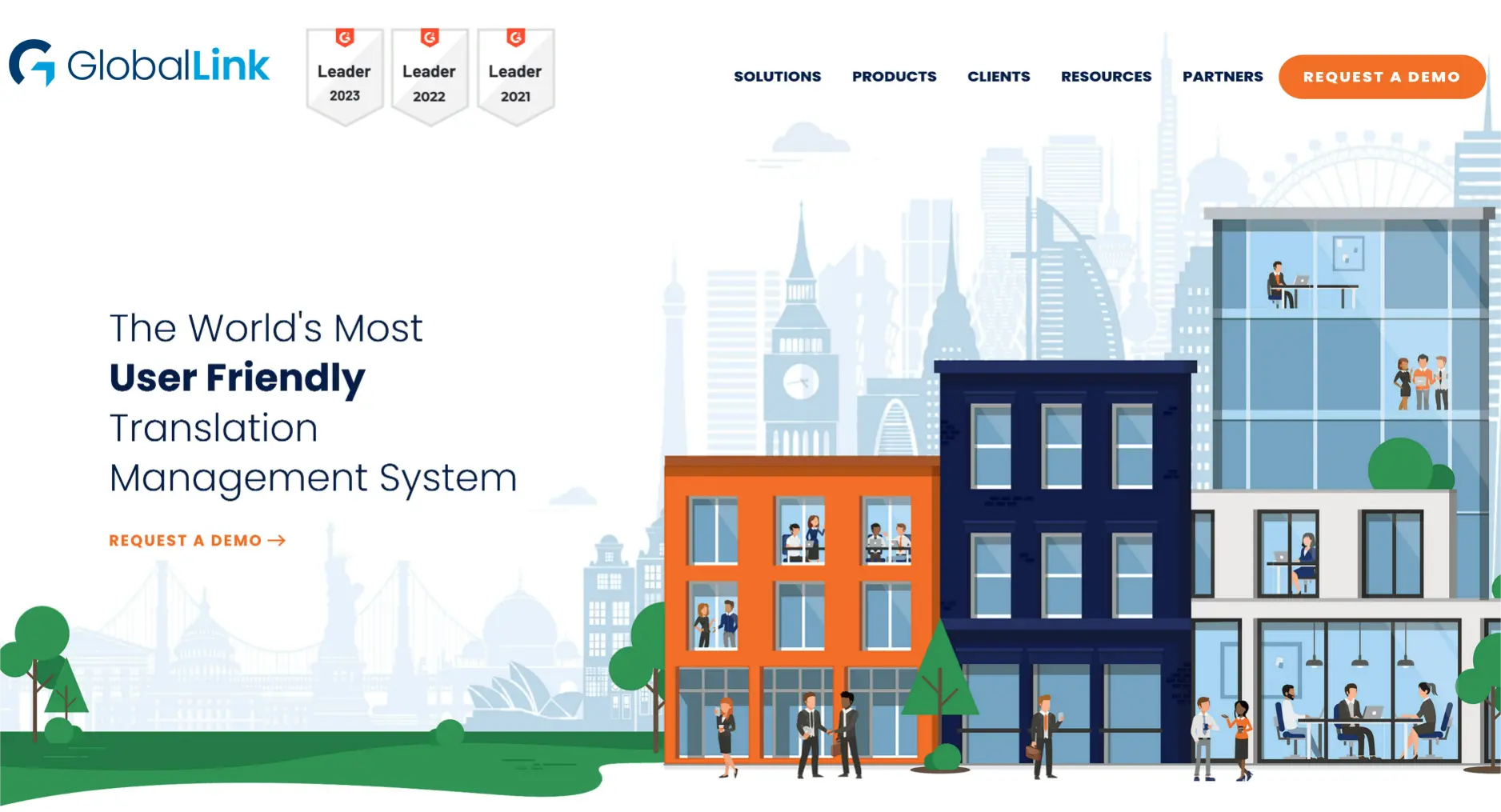
Globalink, a notable player in the 2024 machine translation software arena, offers a versatile and efficient solution for businesses seeking to navigate the global market.
This tool, powered by TransPerfect’s advanced AI, streamlines the translation process, making it faster and more cost-effective. It’s particularly adept at handling various content types, from customer support communications to extensive technical documents.
One of Globalink’s standout features is its AI-driven machine translation (MT) technology. This technology accelerates the translation process and significantly reduces costs, a boon for businesses managing large volumes of content.
Its ability to integrate with various content management systems (CMS) and offer real-time translation adds to its appeal. Moreover, Globalink provides solutions for website localization, ensuring that businesses can effectively communicate with their global audience.
However, Globalink isn’t without its limitations. While it excels in general translation tasks, highly specialized or nuanced content may require human intervention to achieve the desired accuracy and cultural relevance. This is particularly true for technical documents or material with complex jargon.
Globalink is ideal for businesses looking to expand their global footprint. It suits those needing to translate a wide range of content, from internal communications to customer-facing materials.
Retail organizations, in particular, can benefit greatly from their ability to handle diverse content types, ensuring consistent and efficient communication with customers worldwide.
In summary, Globalink emerges as a powerful tool in machine translation, offering AI-powered efficiency, cost savings, and versatility.
Its ability to integrate with existing business systems makes it a valuable asset for companies aiming to globalize their operations.
While it may not replace human translators in specific contexts, it is invaluable in a fast-paced, multilingual global business world.
Wordfast Pro – Best for budget-conscious freelancers

Wordfast Pro secures a top position in the 2024 machine translation software field.
With its robust features and versatility, this MT tool caters to translators, language service providers, and multinational corporations.
As a standalone, multi-platform Translation Memory (TM) tool, it operates natively on Windows, Mac, and Linux, ensuring broad accessibility.
One of Wordfast Pro’s key strengths lies in its user-friendly interface. Users can choose between a tag mark-up editor or a WYSIWYG (What You See Is What You Get) editor, depending on their preference.
This flexibility, combined with customizable shortcut key bindings, makes it easy for users to adapt the software to their workflow. The tool’s target-only live preview allows for efficient proofreading and editing directly within the document, streamlining the translation process.
Wordfast Pro excels in managing multilingual translation projects. It can handle virtually any file format, including those from MS Office, Adobe InDesign, and FrameMaker, as well as various web and software file types.
Its ability to chain multiple files into one file improves consistency and management.
Furthermore, the software integrates with multiple machine translation engines, enabling users to leverage machine translations for unmatched translation memory matches, with the option to assign penalties to machine-translated content.
While Wordfast Pro shines in its advanced features like segment filtering, real-time quality assurance, and support for an unlimited number of TMs and glossaries, it does have its limitations.
The software requires a certain level of technical proficiency, which might challenge less tech-savvy users.
Additionally, while it supports many file formats and languages, its full potential is best realized with human translators for nuanced, context-heavy content.
Ideal for agencies, startups, and enterprises, Wordfast Pro offers a comprehensive solution for managing complex translation projects.
It combines advanced technology with user-centric design, making it a valuable asset for those seeking to enhance their translation workflow in the global market.
Transit NXT Professional+ – Best for complex multilingual projects

Transit NXT Professional+ makes its mark in 2024’s machine translation industry.
This comprehensive package excels in managing, distributing, and executing multilingual translation projects and is designed to meet the needs of corporate localization departments, project managers, and translators.
It shines in document translation, software localization, and video subtitling and includes the TermStar Terminology Management system for enhanced accuracy.
Additionally, its ability to connect to various machine translation engines and process different project formats like Transit (PPF), MemoQ, SDLPPX, and XLIFF makes it a versatile tool.
The software is a perpetual license or subscription, with 3, 6, and 12-month options, providing flexibility for different organizational needs and budgets.
Transit NXT Professional+ can be installed in a network environment, catering to larger teams and complex project requirements. It also includes free service packs, ensuring users can access the latest updates and features.
One of the main advantages of Transit NXT Professional+ is its comprehensive nature, making it ideal for larger organizations and translation agencies that handle various translation and localization tasks.
However, this comprehensiveness might be overwhelming for individual freelancers or small businesses, who might not require all the features offered. Moreover, the cost could be a consideration for smaller entities.
Transit NXT Professional+ is particularly well-suited for businesses that require a robust, all-encompassing translation solution capable of handling complex and varied translation tasks.
Its features make it ideal for those who need to manage large-scale translation projects, localize software and documents, and require a reliable terminology management system.
Its versatility in handling various project formats and network installation capability make it a go-to solution for enterprises looking to streamline their translation processes on a larger scale.
Cloudwords – Best for marketing localization

Cloudwords carves a niche in the 2024 machine translation software sector for businesses seeking efficient management and translation of marketing campaigns, websites, and documents.
This platform, known for simplifying the localization process, allows companies to launch their marketing content swiftly and at a scale that aligns with global objectives.
At its core, Cloudwords offers a seamless way to manage multilingual assets. Its strengths lie in accelerating the localization of assets, eliminating the laborious tasks often associated with translation, and streamlining project management.
This results in a multilingual asset management system that benefits both the team and the customers.
Key features include collaboration and workflow tools, in-context review and approval, integration and auto-creation of assets, translation memory, and project visibility and reporting. These features aim to optimize localization and globalization efforts, enhancing the productivity of marketing localization automation.
However, Cloudwords might not be the one-size-fits-all solution for every business. While it excels in handling large-scale, global marketing campaigns and documentation, companies seeking a more specialized or narrower focus may find it less applicable.
Additionally, its comprehensive nature could overwhelm smaller businesses or those new to localization processes.
Ideal for global enterprises facing the challenges of time-consuming, manual translation processes, Cloudwords offers a streamlined, intuitive SaaS platform. It particularly suits businesses aiming to manage and automate the translation of marketing assets efficiently and at scale.
The platform caters to those needing to rapidly adapt content across multiple languages and regions, making it a valuable tool for companies with a firm or developing international presence.
In summary, Cloudwords stands out in 2024 as a powerful ally for businesses striving to connect with a global audience through compelling, timely, and accurate localized content.
Swordfish Translation Editor – Best for XML-based projects
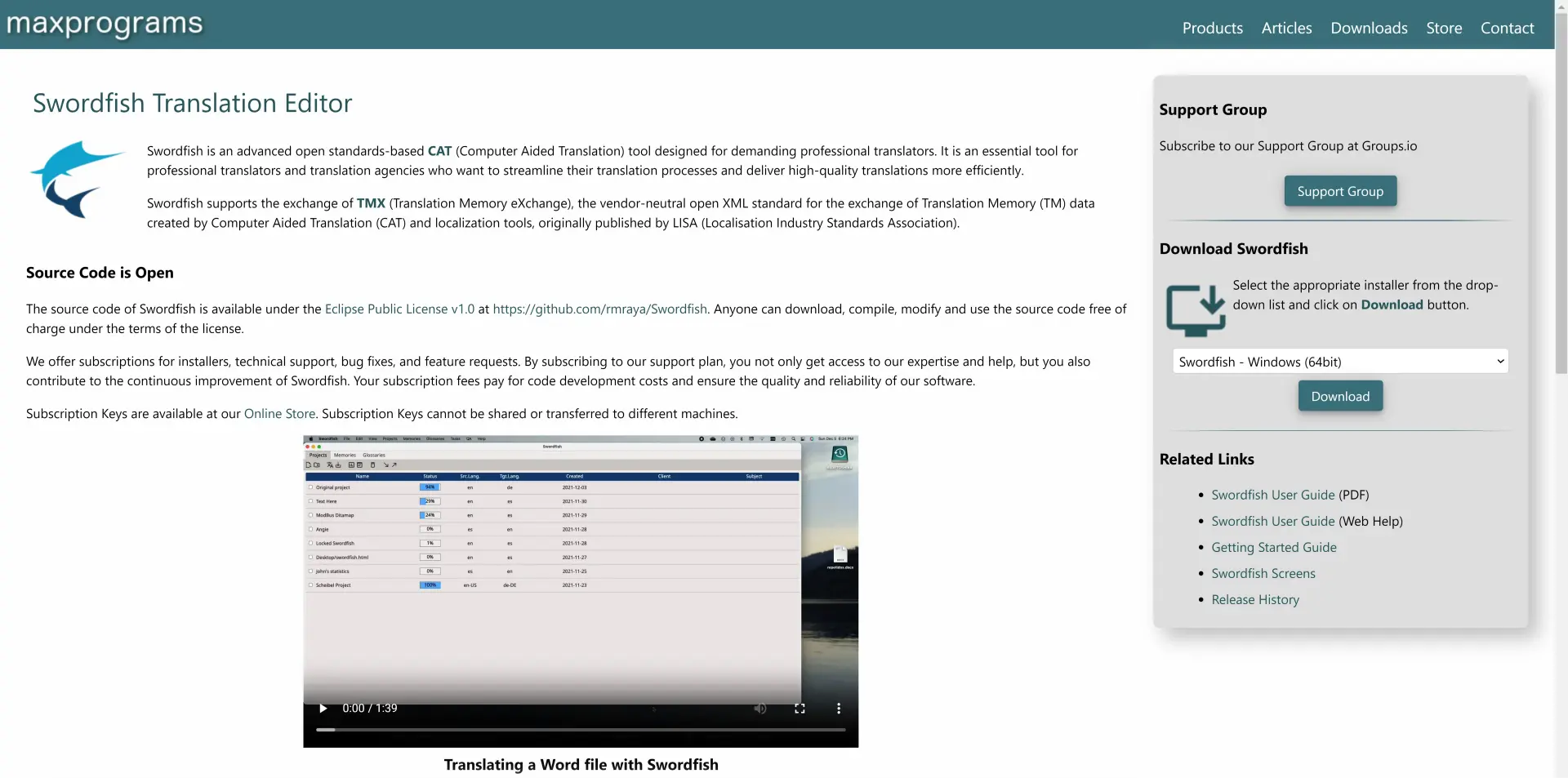
The Swordfish Translation Editor emerges as a notable contender in 2024 in machine translation software.
Designed to meet the demands of professional translators, this Computer Aided Translation (CAT) tool is grounded in open standards, offering robust support for various document formats, including MS Office, DITA, and HTML. Utilizing both Translation Memory (TM) and Machine Translation (MT), Swordfish is adept at handling a wide array of translation tasks.
One of the striking features of Swordfish is its ability to balance high-quality translations with user-friendly functionality. It facilitates efficient translation processes, helping users to manage projects with ease.
The tool’s emphasis on utilizing open standards like XLIFF 1.2 and TMX (Translation Memory eXchange) enhances its versatility and interoperability, making it a suitable choice for various translation scenarios.
However, Swordfish isn’t without its limitations. The complexity of its features might pose a learning curve for beginners in the translation field.
Additionally, while it excels in handling standard translation tasks, its performance on highly specialized or niche language projects may vary.
Swordfish is an ideal tool for professional translators and translation agencies seeking to streamline their workflows while maintaining high-quality standards. It’s particularly well-suited for those dealing with diverse document formats and requiring a tool that integrates TM and MT capabilities.
In summary, Swordfish Translation Editor stands out for its comprehensive feature set and open standards approach, making it a valuable asset for translation professionals in 2024.
While it offers numerous benefits in terms of functionality and support for various formats, potential users should weigh its complexity against their own experience and specific translation needs.
POEditor – Best for app and website localization
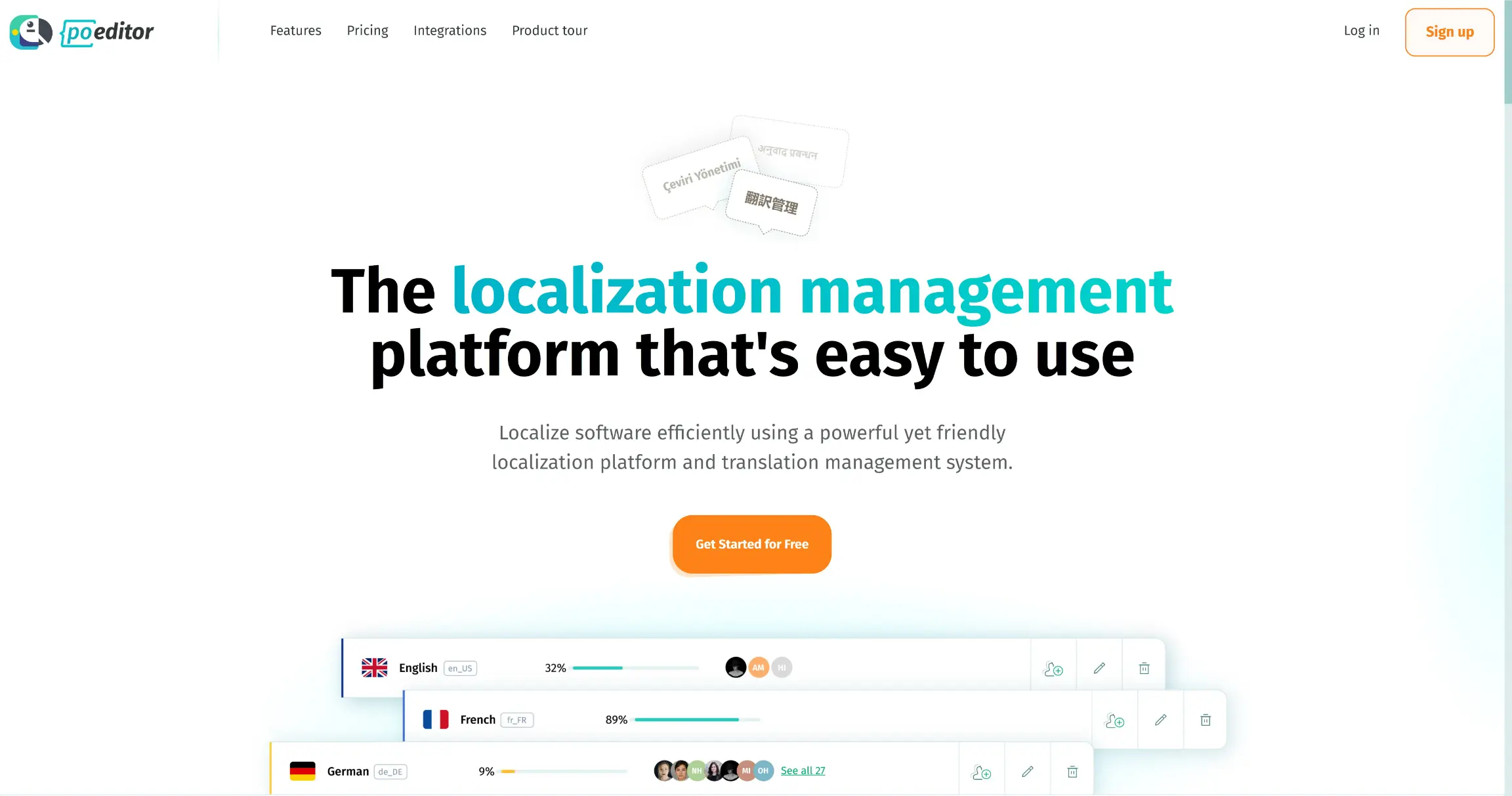
POEditor earns recognition as a top choice in 2024’s machine translation software race, especially for those seeking budget-friendly localization solutions.
This tool benefits open-source projects, offering free access that significantly eases localization. Its user-friendly interface simplifies multilingual content management, enhancing collaboration and streamlining workflows.
A unique feature of POEditor is its use of tags, which adds a layer of flexibility and precision in managing translations, which is crucial for projects requiring granular control.
However, POEditor isn’t without its limitations. A notable drawback is the inability to manually order translation keys, which can be a minor hindrance for projects that need specific critical sequencing.
Despite this, its cost-effectiveness, user-friendly design, and unique features make POEditor an attractive option for diverse localization needs.
Users praise POEditor for its ability to display translation progress, keeping them motivated toward completion. The platform’s UI/UX is commendable, focusing on context and translating without distractions.
On the downside, the credit system for automated translations might not suit all users, particularly those requiring context-specific translations.
Another strength of POEditor lies in its API, which allows seamless integration with other programs. This feature helps update language translations in various applications, including mobile apps. The platform supports numerous file formats for import and export, facilitating easy product implementation.
However, the price increase can be a significant factor for users beyond the free tier, especially for smaller or open-source applications with limited profits.
Overall, POEditor is a solid choice for businesses and developers seeking a simple, straightforward, and effective tool for managing translation and localization. Its simplicity, clarity, and ability to provide additional information for translation contexts are highly valued by its users.
LingoHub – Best for seamless software translation

Among 2024’s machine translation offerings, LingoHub is a prime option for businesses seeking a comprehensive translation management platform. It caters to various software translation needs, including websites, mobile apps, desktop applications, and more.
This platform offers a 360-degree overview, allowing users to manage translation progress, localization teams, and finances all in one interface. With its focus on optimizing the localization process through various text management features, LingoHub streamlines the workflow for businesses of all sizes.
Critical features of LingoHub include quality checks, term bases, translation history, translation memory, style guides, and management tools for translation teams. These features ensure high-quality translations, maintain project consistency, and support collaborative efforts.
LingoHub’s machine translation capability, powered by engines like DeepL, Amazon Translate, and Google Translate, provides highly accurate translations, supporting over a hundred languages. This ensures businesses can speak to their customers worldwide with clarity and precision.
One of the main advantages of LingoHub is its robust translation memory, which learns in real time and stores previous translations. This feature significantly speeds up the localization process by avoiding the need to re-translate recurrent text segments.
Additionally, LingoHub’s style guide and term base help maintain a consistent tone and accurate terminology across all translations, essential for businesses aiming to establish a solid global presence.
However, while LingoHub offers extensive features and benefits, it may present a learning curve for new users due to its comprehensive nature. It’s most suitable for organizations that require a full-scale translation management solution, including managers, developers, translators, and designers involved in multilingual projects.
In summary, LingoHub is an excellent choice for businesses seeking a powerful, all-encompassing translation management tool. Its blend of advanced features and automation capabilities makes it a valuable asset for any company aiming to navigate the global market effectively.
Text United – Best for integrated translation solutions
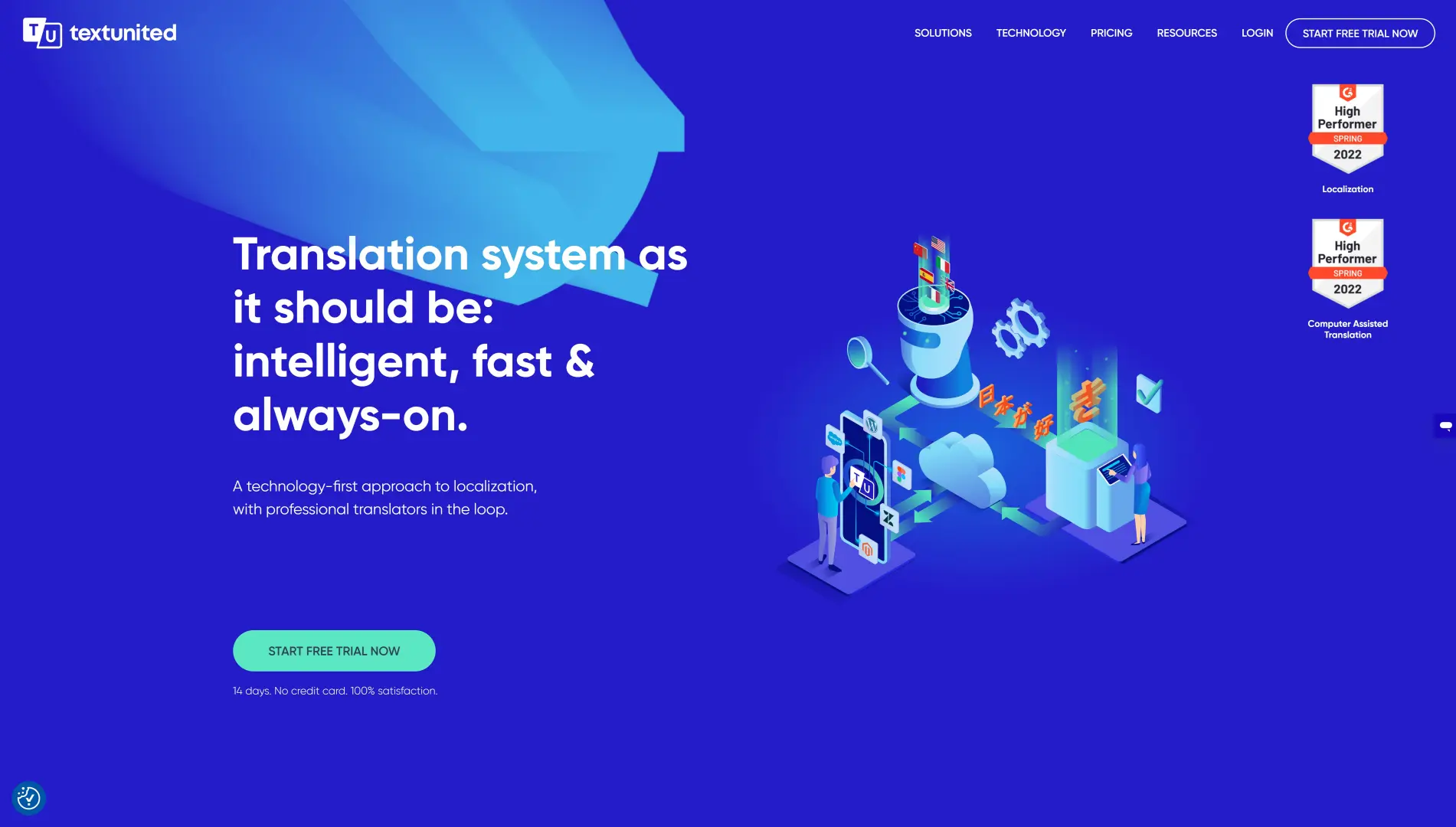
Text United is a leading contender in 2024’s machine translation software landscape, particularly for tech companies. It’s a technology-driven localization system that integrates professional translators into the process. Text United specializes in reducing the complexity of translations and ensuring international growth, backed by robust support.
Text United thrives on its ability to supercharge multilingual support and communication, translating various content types and digital products. It establishes continuous business localization processes, streamlines language handling, and fosters seamless integration between systems, language technology, and professional translators.
A key feature is its ability to revolutionize the translation supply chain, connecting users directly to linguistic talent while controlling language data. This reduces overhead costs and administrative tasks, offering a secure environment for confidential and intellectual property translations.
Text United offers a range of pricing plans catering to different business needs, from occasional users to global companies requiring customized services.
All plans include content filtering from over 30 file types, unlimited projects and languages, access to managed translation services, and an online collaborative CAT tool. The software integrates machine translation from leading vendors, including a private engine trained on your content and a Terminology Manager.
Pros of Text United include its comprehensive features, capability to handle high translation volumes, and suitability for internal team use and on-demand services.
It may, however, be less ideal for smaller businesses or those with infrequent translation needs due to its focus on large-scale and continuous translation processes.
Overall, Text United is a robust solution for tech companies and large businesses looking to streamline their translation processes and expand their global reach. It offers a balance of automated and human translation, ensuring accuracy and efficiency in multilingual communication.
Systran Translate Pro – Best for instant professional translations
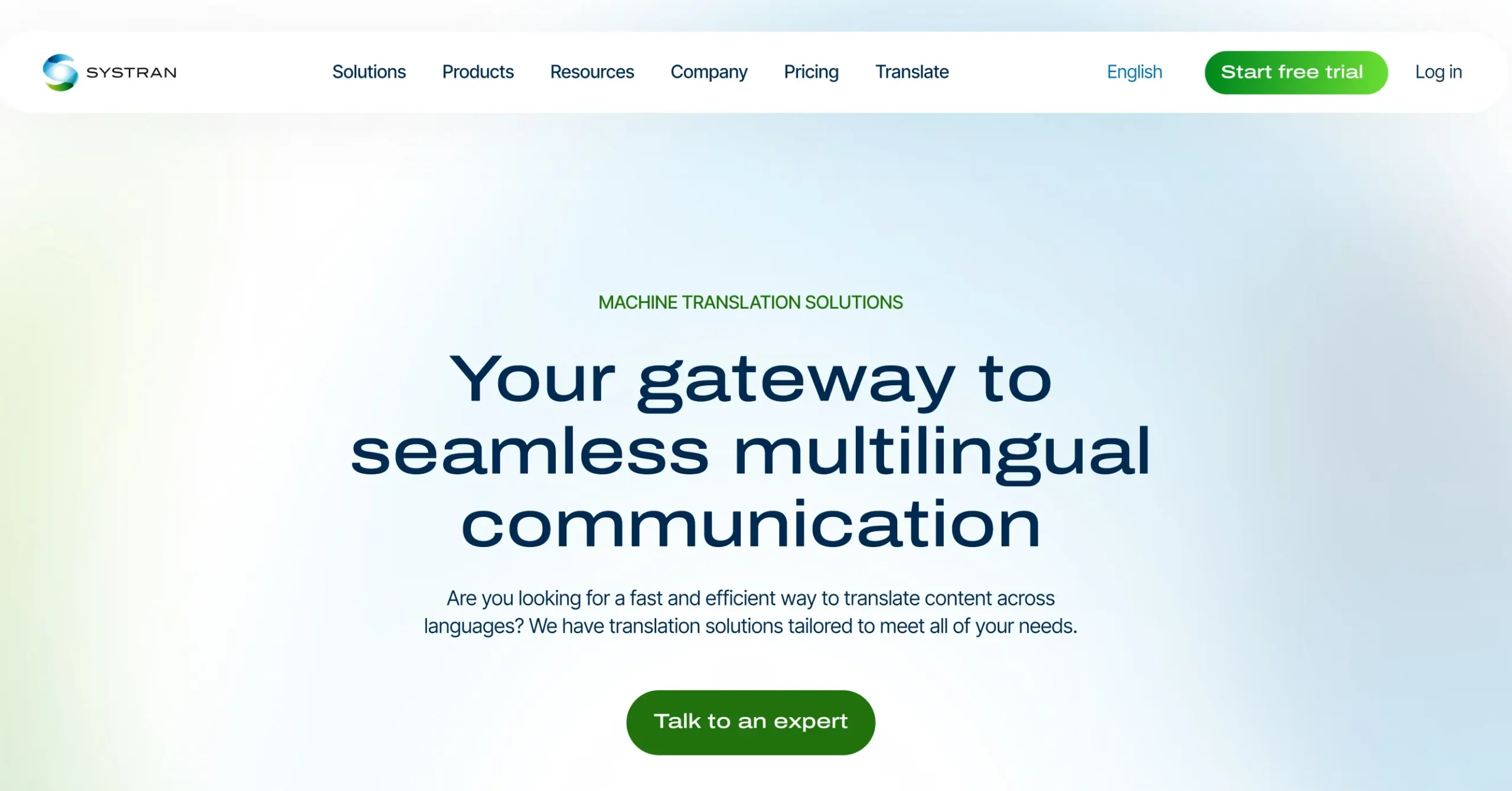
Catering to professionals, Systran Translate Pro software offers a seamless translation experience, making it easier for small businesses to engage with a global audience. With the capability to translate documents in over 55 languages, Systran Translate Pro stands out for its accuracy and speed.
One of the critical features of Systran Translate Pro is its ability to maintain the original layout, graphs, and illustrations in translated documents.
Users can upload files in various formats like Word, PowerPoint, Excel, or PDF and receive instantly translated versions. The software’s prowess extends to website and image translation, showcasing its versatility.
Customized dictionaries allow for tailoring translations to specific needs, enhancing consistency and productivity.
While Systran Translate Pro is highly reliable, requiring little to no edits for essential translations, it excels in technical areas, benefiting from decades of development and experience.
The software automatically detects the source language, simplifying the translation process further. Its ability to understand and translate dialects of Arabic is especially noteworthy, making it a valuable tool in diverse linguistic scenarios.
However, some users find the tool less intuitive and note a learning curve.
Also, a minor drawback is the absence of a dedicated app for iOS and Android platforms.
Ideal for a range of users from translators to education professionals and extensive IT services, Systran Translate Pro, caters to various translation needs. Its functionality and ease of use make it a preferred choice for translating websites, documents, and more.
The software benefits individuals and businesses requiring quick, accurate translations across multiple languages and formats, including specialized professional domains like legal, IT, and finance.
With a 14-day free trial, Systran Translate Pro offers a glimpse into its efficient translation capabilities, proving its worth in machine translation tools.
Conclusion
As we wrap up our exploration of the best machine translation software in 2024, it’s clear that the landscape of machine translation has evolved remarkably.
This year’s standout tools have redefined the boundaries of language translation, offering solutions catering to various needs and preferences.
From ensuring the confidentiality of sensitive data to facilitating collaborative projects across borders, these tools have addressed critical challenges in the translation industry.
The advancements in AI and neural networks have played a pivotal role in enhancing the quality of translations.
Today’s software delivers accuracy and fluency to translations that were once thought impossible.
This technological leap has bridged the gap between machine-generated translations and the nuanced understanding of human translators.
Moreover, the diversity of features available in these tools demonstrates an acute awareness of the varied requirements of different users – be it freelance translators, global enterprises, or tech startups.
One of the most significant developments in this field is the move towards user-friendly interfaces and seamless integration capabilities.
These features have made high-quality translations more accessible to a broader audience, enabling individuals and businesses to communicate effectively in the global marketplace.
Additionally, the emphasis on security and data privacy reflects the growing awareness of the critical importance of protecting sensitive information in the digital age.
As we look to the future, it’s evident that machine translation software will continue to play an indispensable role in breaking down language barriers and fostering global communication.
Whether you’re a professional translator, a multinational corporation, or an individual with occasional translation needs, the advancements in machine translation technology are opening up new horizons for effective and efficient cross-linguistic interactions.
The key is to choose the tool that aligns best with your specific needs, ensuring that your communication is not just translated but truly understood.

